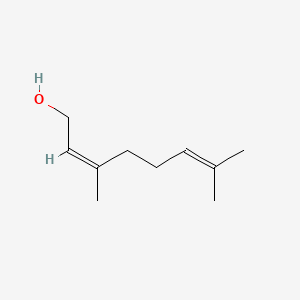| Authors | Title | Published | Journal | PubMed Link |
|---|---|---|---|---|
| Sarıkahya NB et al. | Phytochemical analysis of the essential oils of 10 endemic Cephalaria species from Turkey. | 2013 | Nat. Prod. Res. | pmid:22757667 |
| Chaudhary SC et al. | Geraniol inhibits murine skin tumorigenesis by modulating COX-2 expression, Ras-ERK1/2 signaling pathway and apoptosis. | 2013 | J Appl Toxicol | pmid:22760862 |
| Sharma PK et al. | Biochemical characteristics of a novel vegetative tissue geraniol acetyltransferase from a monoterpene oil grass (Palmarosa, Cymbopogon martinii var. Motia) leaf. | 2013 | Plant Sci. | pmid:23415329 |
| Camelo-Méndez GA et al. | Comparative study of anthocyanin and volatile compounds content of four varieties of Mexican roselle (Hibiscus sabdariffa L.) by multivariable analysis. | 2013 | Plant Foods Hum Nutr | pmid:23715788 |
| Rekha KR et al. | Geraniol ameliorates the motor behavior and neurotrophic factors inadequacy in MPTP-induced mice model of Parkinson's disease. | 2013 | J. Mol. Neurosci. | pmid:23943375 |
| Lübbert M et al. | Transient receptor potential channels encode volatile chemicals sensed by rat trigeminal ganglion neurons. | 2013 | PLoS ONE | pmid:24205061 |
| Dong L et al. | Characterization of two geraniol synthases from Valeriana officinalis and Lippia dulcis: similar activity but difference in subcellular localization. | 2013 | Metab. Eng. | pmid:24060453 |
| Tricarico PM et al. | Temperature and drug treatments in mevalonate kinase deficiency: an ex vivo study. | 2013 | Biomed Res Int | pmid:24073415 |
| Shah AA et al. | RecA-mediated SOS response provides a geraniol tolerance in Escherichia coli. | 2013 | J. Biotechnol. | pmid:23906844 |
| Ghosh S et al. | Induction of senescence and identification of differentially expressed genes in tomato in response to monoterpene. | 2013 | PLoS ONE | pmid:24098759 |
| Khan AQ et al. | Geraniol attenuates 12-O-tetradecanoylphorbol-13-acetate (TPA)-induced oxidative stress and inflammation in mouse skin: possible role of p38 MAP Kinase and NF-κB. | 2013 | Exp. Mol. Pathol. | pmid:23399806 |
| Malecki E et al. | Mitsunobu reactions of 5-fluorouridine with the terpenols phytol and nerol: DNA building blocks for a biomimetic lipophilization of nucleic acids. | 2013 | Chem. Biodivers. | pmid:24327441 |
| Ramilijaona J et al. | Enzymatic modification of palmarosa essential oil: chemical analysis and olfactory evaluation of acylated products. | 2013 | Chem. Biodivers. | pmid:24327448 |
| Rekha KR et al. | Geraniol attenuates α-synuclein expression and neuromuscular impairment through increase dopamine content in MPTP intoxicated mice by dose dependent manner. | 2013 | Biochem. Biophys. Res. Commun. | pmid:24103762 |
| Liu J et al. | Overproduction of geraniol by enhanced precursor supply in Saccharomyces cerevisiae. | 2013 | J. Biotechnol. | pmid:24161921 |
| Paterson A et al. | Environmental and seasonal influences on red raspberry flavour volatiles and identification of quantitative trait loci (QTL) and candidate genes. | 2013 | Theor. Appl. Genet. | pmid:22890807 |
| Pellati F et al. | Gas chromatography combined with mass spectrometry, flame ionization detection and elemental analyzer/isotope ratio mass spectrometry for characterizing and detecting the authenticity of commercial essential oils of Rosa damascena Mill. | 2013 | Rapid Commun. Mass Spectrom. | pmid:23413218 |
| Tian J et al. | Investigations on the antifungal effect of nerol against Aspergillus flavus causing food spoilage. | 2013 | ScientificWorldJournal | pmid:24453813 |
| Steyer D et al. | Genetic analysis of geraniol metabolism during fermentation. | 2013 | Food Microbiol. | pmid:23200656 |
| Boukhatem MN et al. | Rose geranium essential oil as a source of new and safe anti-inflammatory drugs. | 2013 | Libyan J Med | pmid:24103319 |
Nerol
Nerol is a lipid of Prenol Lipids (PR) class. The involved functions are known as Odorant, Anabolism, Diastasis, Metabolic Inhibition and Oxidation. Nerol often locates in germ tube. The related lipids are Octanols, Pinene, Hexanols, ethyl butyrate and ethyl hexanoate.
Cross Reference
Introduction
To understand associated biological information of Nerol, we collected biological information of abnormalities, associated pathways, cellular/molecular locations, biological functions, related genes/proteins, lipids and common seen animal/experimental models with organized paragraphs from literatures.
What diseases are associated with Nerol?
There are no associated biomedical information in the current reference collection.
No disease MeSH terms mapped to the current reference collection.
PubChem Associated disorders and diseases
What pathways are associated with Nerol
There are no associated biomedical information in the current reference collection.
PubChem Biomolecular Interactions and Pathways
Link to PubChem Biomolecular Interactions and PathwaysWhat cellular locations are associated with Nerol?
Visualization in cellular structure
Associated locations are in red color. Not associated locations are in black.
Related references are published most in these journals:
| Location | Cross reference | Weighted score | Related literatures |
|---|
What functions are associated with Nerol?
Related references are published most in these journals:
| Function | Cross reference | Weighted score | Related literatures |
|---|
What lipids are associated with Nerol?
Related references are published most in these journals:
| Lipid concept | Cross reference | Weighted score | Related literatures |
|---|
What genes are associated with Nerol?
There are no associated biomedical information in the current reference collection.
What common seen animal models are associated with Nerol?
There are no associated biomedical information in the current reference collection.
